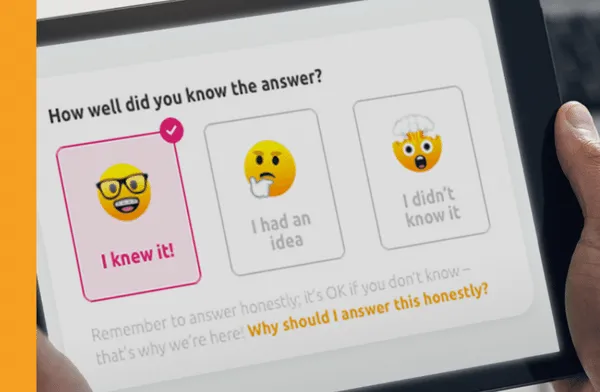
Effective Retail Training for Disparate Workforces
In the retail industry, maintaining high performance can be challenging due to the dispersed nature of the workforce. This poses additional challenges for companies, particularly in terms of onboarding and reinforcing training. With constant product updates and evolving practices, it is crucial for a company’s long-term survival to effectively deliver new information to employees while ensuring consistency and quality. This can be achieved through digital training. At Wranx, we transform your training content into a digital format and deliver it to learners. Our unique platform breaks down training into manageable pieces, which are repetitively shown to learners over time. Through our “daily drills,” all learners receive the same content, regardless of their location. This allows you to have full visibility into what your employees are learning and eliminates the need to send trainers across the globe.
Here, There, Everywhere
Effective communication can be a formidable hurdle for businesses with a disparate workforce. Let’s consider this scenario: You oversee a specialty clothing company with an upcoming major product launch. Ensuring the right information reaches all store employees is crucial. Unfortunately, despite an initial training session, there is no follow-up reinforcement to help them retain the knowledge. Customers often evaluate a product’s value in relation to its price. Thus, sales assistants require up-to-date product knowledge and strong communication skills to secure sales. Given the significant impact on employee performance, it becomes vital to provide consistent and engaging training. As we recognize the advantages of digital training, it begs the question: Is traditional classroom training truly sufficient?
What are your employees retaining?
There is a common misconception that once employees learn something, they will automatically remember it. Unfortunately, as humans, we are prone to forgetfulness. This becomes even more challenging when you have employees working in different locations, as it becomes difficult to keep track of who knows what. Without proper reinforcement, the value of initial training diminishes over time, as employees are not incentivized to retain what they have learned. This can lead to significant financial implications.
Success in the Workplace
Wranx has experienced consistent success in collaboration with The North Face, the renowned retail company specializing in outdoor clothing and pioneering technological advancements. Having already trained over 2,000 learners, Wranx anticipates a substantial increase in this figure.
What was needed?
Through Wranx’s customized content conversion process, The North Face’s learning materials were transformed into easily digestible 50-question modules, perfectly designed for maximum impact.
The North Face’s commitment to self-improvement highlighted the necessity for continuous and effective training across various disciplines including product knowledge, customer service, and behavior-based training. Their ultimate objective with Wranx was to elevate the customer experience by establishing a solid foundation of product knowledge within their workforce.
What was delivered?
According to reports from The North Face, users found it easier to retain what they had learnt using Wranx’s method of repeating questions over time. As a result, The North Face observed a direct improvement in customer experiences. Positive customer reviews revealed that purchasing decisions were heavily influenced by staff members’ advanced product knowledge. These findings are supported by the fact that 87% of users felt that training with Wranx would enhance their performance in their respective roles. This clearly demonstrates the remarkable value added by Wranx. By engaging in daily drills, employees consistently reinforced their understanding of key product information, preventing it from being forgotten.
Click here to read our case study with The North Face
The Wranx Approach
The Wranx platform explores the synergy of advanced e-learning technology and science proven to foster employee knowledge retention. By mitigating our natural memory fade, Wranx optimizes long-term learning efficacy. Information is strategically presented at spaced intervals, tailored to individual confidence levels. This gradual reinforcement effortlessly reinforces knowledge, countering our mind’s predisposition to forget.
Measuring your employees’ progress
Wranx Analytics offers a comprehensive solution for tracking employee performance. It provides a centralized platform where employers can easily access data and filter it by team or division. This allows for a detailed breakdown of training progress by region. With just a few clicks, employers can gain valuable insights into learner confidence and completion rates.
By cross-referencing this data with employee performance, employers can effectively measure the impact of Wranx training on knowledge and confidence levels.
In addition to daily drills, Wranx offers multiple-choice assessments, including Certainty Based Marking (CBM) assessments. These assessments add another layer to training, by providing measurable feedback on employee’s confidence in their knowledge. This valuable option helps identify areas for improvement and allows employers to gain deeper insights into what employees know and how confident they are in their answers. For instance, The North Face managers discovered that 80% of learners improved their CBM scores, highlighting the effectiveness of Wranx as a powerful learning tool.
Why Is Wranx Worth It?
A diverse workforce has the potential to feel disconnected from their organization. However, by providing an inclusive training method, staff will feel more connected and aligned with the organization’s goals. This stems from a place of confidence and pride in performing their jobs well. Achieving this outcome is made possible with Wranx. Our platform combines innovative e-learning technology with established memory science, maximizing learners’ ability to retain crucial information. With its natural adaptability, Wranx can cater to each company’s specific needs and deliver various types of training, from product knowledge to customer care for vulnerable individuals. Managing a diverse workforce becomes more efficient with Wranx, reducing training costs by streamlining its delivery. Furthermore, our focus on analytics allows employers to monitor employee progress, measure development, and ensure consistent, high-quality training content regardless of their location.



